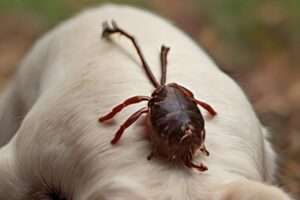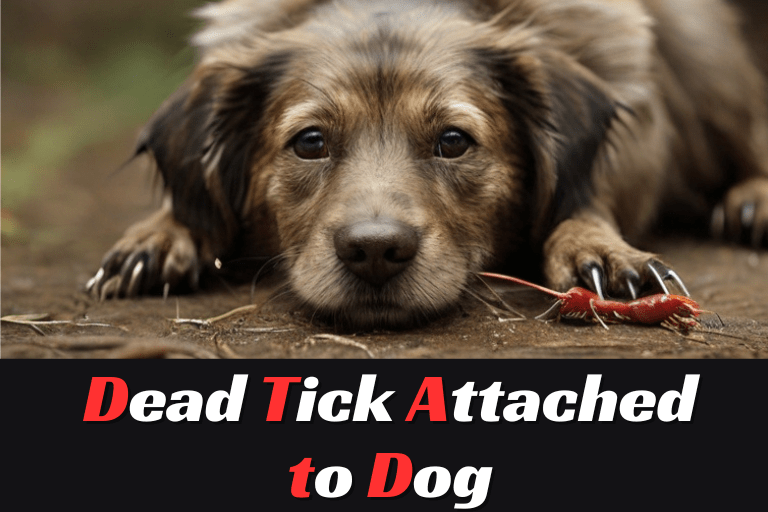Dead Tick Attached to Dog
Ticks are tiny, blood-sucking parasites that can pose serious health risks to dogs.
While discovering a tick attached to your furry friend can be alarming, finding a dead tick raises its own set of concerns.
In this comprehensive guide, we’ll delve into the world of ticks, explore the risks associated with dead ticks, and provide practical advice on how to safely handle the situation.
I. Introduction
Ticks are arachnids that belong to the order Parasitiformes. These ectoparasites feed on the blood of animals, including dogs, and can transmit a variety of diseases.
Dogs are particularly susceptible to tick bites due to their outdoor activities and thick fur, making them prime targets for these parasites.
II. Understanding Ticks

Types of Ticks
There are several species of ticks, including the American dog tick, black-legged tick (deer tick), and brown dog tick, among others. Each species has its own preferred host and geographic distribution.
Life Cycle of Ticks
Ticks have four life stages: egg, larva, nymph, and adult. They require a blood meal at each stage to progress to the next. Depending on the species, the life cycle can take several weeks to years to complete.
Diseases Transmitted by Ticks
Ticks are notorious vectors of disease and can transmit various pathogens to dogs. Common tick-borne illnesses include Lyme disease, ehrlichiosis, anaplasmosis, and Rocky Mountain spotted fever.
III. Identifying a Dead Tick Attached to a Dog
Visual Appearance
A dead tick may appear engorged or shriveled, depending on how long it has been feeding before it died. It may be flattened against the dog’s skin, making it harder to distinguish from live ticks.
How to Distinguish Between Live and Dead Ticks
To determine if a tick is dead, gently touch it with a pair of tweezers or a gloved hand. If the tick does not move or react to stimuli, it is likely dead. However, exercise caution as some ticks may still be alive but in a dormant state.
IV. Risks Associated with Dead Ticks

Disease Transmission Risk
While dead ticks cannot actively transmit diseases, they may still harbor infectious agents. If the tick was carrying pathogens before it died, there is a potential risk of disease transmission if the tick was attached to the dog for a sufficient period.
Allergic Reactions
Some dogs may develop allergic reactions to tick saliva, even if the tick is dead. This can manifest as localized swelling, itching, or redness at the bite site.
V. How to Remove a Dead Tick from a Dog
Safe Removal Techniques
To remove a dead tick, grasp it as close to the skin as possible using fine-tipped tweezers. Apply steady, gentle pressure and pull the tick straight out without twisting or jerking.
Tools Required for Tick Removal
- Fine-tipped tweezers
- Tick removal tool
- Latex gloves (optional)
VI. Precautions After Tick Removal

Disposal of the Tick
Dispose of the dead tick by flushing it down the toilet, sealing it in a plastic bag, or crushing it between two hard surfaces.
Cleaning the Bite Area
Clean the bite site with antiseptic solution or soap and water to reduce the risk of infection.
Monitoring the Dog for Symptoms
Monitor your dog for any signs of illness, such as fever, lethargy, lameness, or loss of appetite, in the days following tick removal.
VII. Seeking Veterinary Advice
When to Consult a Veterinarian
If you’re unsure about how to safely remove a tick, or if your dog exhibits symptoms of tick-borne illness, consult your veterinarian promptly.
Importance of Professional Evaluation
Your veterinarian can provide appropriate treatment and diagnostic testing if necessary, ensuring your dog receives the care they need.
VIII. Preventative Measures

Tick Prevention Methods
- Use topical or oral tick preventatives recommended by your veterinarian.
- Keep your dog’s outdoor environment clean and free of tick habitats.
- Avoid areas with dense vegetation or high tick populations.
Regular Tick Checks
Perform regular tick checks on your dog after outdoor activities, paying close attention to areas such as the ears, neck, and between the toes.
IX. Conclusion
In conclusion, discovering a dead tick attached to your dog may be unsettling, but it’s essential to handle the situation calmly and effectively.
By understanding the risks associated with dead ticks and following proper removal and preventative measures, you can help protect your furry companion from tick-borne diseases.
Remember to consult your veterinarian if you have any concerns or if your dog exhibits signs of illness after tick exposure.
FAQs About Dead Tick Attached to Dogs
Here are some FAQs related to Dead Tick Attached to Dog.
- Q: Can a dead tick still transmit diseases to my dog?
- A: While the risk is lower compared to live ticks, there is still a potential for disease transmission if the tick was carrying pathogens before it died. Monitor your dog for any signs of illness and consult your veterinarian if necessary.
- Q: How long does it take for a tick to die after feeding on a dog?
- A: The lifespan of a tick can vary depending on factors such as species, environmental conditions, and the dog’s immune response. In some cases, a tick may die shortly after feeding, while others may remain attached for several days before dying.
- Q: What should I do if I find a dead tick on my dog?
- A: Use fine-tipped tweezers to safely remove the tick from your dog’s skin, taking care to avoid crushing the tick’s body. Dispose of the tick properly and clean the bite site with antiseptic solution or soap and water.
- Q: Can my dog have an allergic reaction to a dead tick?
- A: Yes, some dogs may develop allergic reactions to tick saliva, even if the tick is dead. Monitor your dog for signs of localized swelling, itching, or redness at the bite site and seek veterinary advice if necessary.
- Q: How can I prevent tick infestations on my dog?
- A: Use tick preventatives recommended by your veterinarian, perform regular tick checks, and avoid areas with dense vegetation or known tick habitats to reduce the risk of tick infestations.
Related Posts:
- Let’s understand: Aggression in French Bulldogs 5 Reasons
- Let’s understand: Full Grown French Bulldog with Floppy Ears in 2024
- Let’s understand: Why Are Pugs So Ugly? 5 Reasons
- Let’s understand: Top 10 Dog Breeds with an Underbite in 2024
- Let’s understand Is Pura Safe for Cats?

